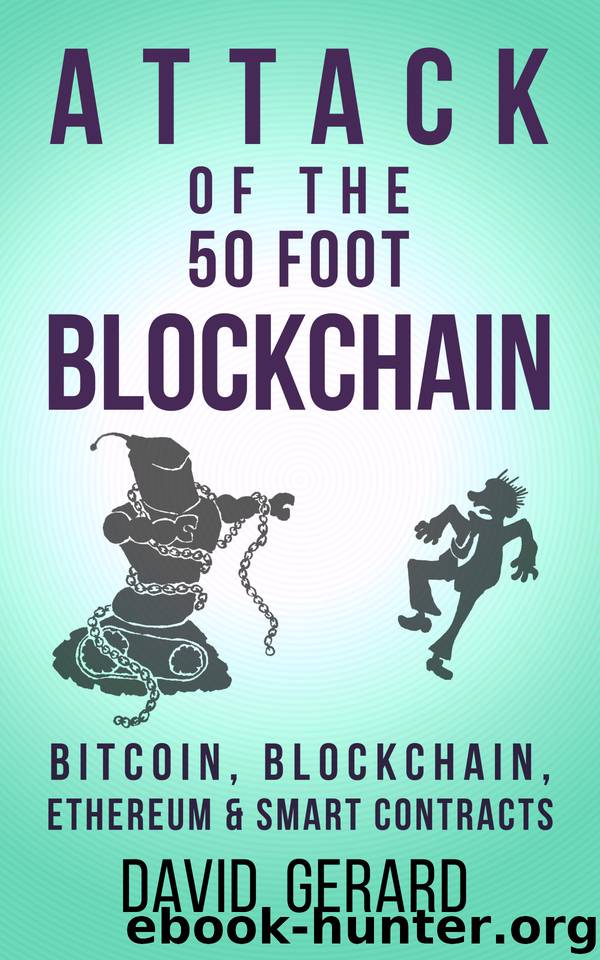Attack of the 50 Foot Blockchain by David Gerard

Author:David Gerard [Gerard, David]
Language: eng
Format: epub
Tags: bitcoin, blockchain, smart contract, mark karpeles, bitfinex, mt. gox, pirateat40, singulardtv, ethereum, ico, dogecoin, distributed ledger technology, satoshi, satoshi nakamoto, craig wright, imogen heap, berklee rethink
Published: 0101-01-01T00:00:00+00:00
ICOs: magic beans and bubble machines
There is nothing in the world more helpless and irresponsible and depraved than a man in the depths of an ether binge.
– Hunter S. Thompson, Fear and Loathing in Las Vegas
The snappy new phrase for “buy our premined altcoin” is “ICO” (“Initial Coin Offering” or “Initial Crowdfunding Offering”). These are typically tokens running on top of the Ethereum blockchain, usually in a smart contract written to the standard ERC-20 interface.308
There’s no mining involved – you create a smart contract that manages a pile of tokens, sell a small percentage and hold the rest to sell later. You also keep centralised control over the token. If it’s ERC-20 compliant, it’s easy for an exchange to trade in it.
An ICO makes sense for crowdfunding in very limited conditions – if you have a technical problem that requires decentralised, cryptographically verified tokens (if it doesn’t need tokens, they shouldn’t be bolted on); if the tokens are directly usable on the platform itself; if at least a proof-of-concept of the technology verifiably exists. It also helps if the idea is even plausible as a business. Unsurprisingly, most ICOs don’t meet these criteria.
Token offerings have been around a while, but kicked off enormously in the second bubble. The usual pretext is crowdfunding, but in practice the tokens are just traded on the exchanges as commodities. The creators then cash in. The value proposition for buyers is, as for the creators, easy money in a bubble.
Bancor’s ICO raised $144 million with none of the due diligence of an ordinary Initial Public Offering, the barest prospectus and no indication their plan (a “market maker” to sell altcoins that aren’t selling otherwise) would even work. This is clearly superior, for a certain type of seller, to the IPO bubble of the dot-com era, in that these aren’t actually shares, and the purchasers have no influence over the funded enterprise even in theory.
The ideas themselves are as bad as the worst dot-com IPOs. Digix, the first token crowdsale on the Ethereum blockchain itself, is a cryptocurrency backed by gold;309 Golem offers a “decentralized” (buzzword alert!) market in computing, like Amazon Web Services except you can only pay using their token;310 Gnosis offers semiautomatic prediction markets using their token;311 SingularDTV is a bizarre plan to fund a TV show about the Singularity in which a Caribbean island adopts Ethereum as its currency and Austrian economics works (this one gets its own section later in the book); Iconomi is an index fund of other ICOs.312
The token smart contracts are often incompetent in both intended functionality and programming ability.313 This turns out not to matter as long as they do the basic job: attract buyers and sell tokens. Status raised 300,000 ETH (then over $100 million) to … write an Ethereum phone app. Hopefully that’s enough to develop a phone app! It sold out in just a few hours. The actual promises as to what people will get for that $100 million are typical:314
Risk of abandonment /
Download
This site does not store any files on its server. We only index and link to content provided by other sites. Please contact the content providers to delete copyright contents if any and email us, we'll remove relevant links or contents immediately.
Pioneering Portfolio Management by David F. Swensen(5605)
Rich Dad Poor Dad by Robert T. Kiyosaki(5147)
How To Win Friends and Influence People by Dale Carnegie(3770)
The Money Culture by Michael Lewis(3284)
The Dhandho Investor by Mohnish Pabrai(3167)
The Wisdom of Finance by Mihir Desai(3077)
Liar's Poker by Michael Lewis(2810)
The Intelligent Investor by Benjamin Graham Jason Zweig(2596)
The ONE Thing by Gary Keller(2518)
Mastering Bitcoin: Programming the Open Blockchain by Andreas M. Antonopoulos(2509)
Investing For Dummies by Eric Tyson(2470)
How to Day Trade for a Living: Tools, Tactics, Money Management, Discipline and Trading Psychology by Andrew Aziz(2444)
How to Win Friends and Influence People by Dale Carnegie(2435)
Rich Dad Poor Dad: What The Rich Teach Their Kids About Money - That The Poor And Middle Class Do Not! by Robert T. Kiyosaki(2434)
Fooled by Randomness: The Hidden Role of Chance in Life and in the Markets by Nassim Nicholas Taleb(2412)
Zero Hour by Harry S. Dent Jr. & Andrew Pancholi(2246)
Market Wizards by Jack D. Schwager(2163)
Rich Dad's Guide to Investing by Robert T. Kiyosaki(2110)
How to Pay Zero Taxes, 2018 by Jeff A. Schnepper(2098)
